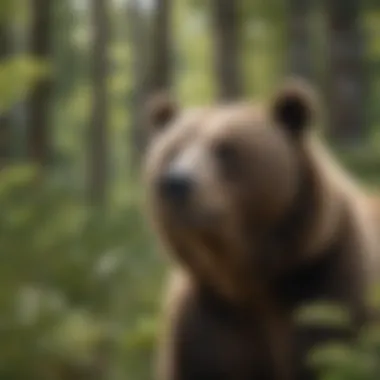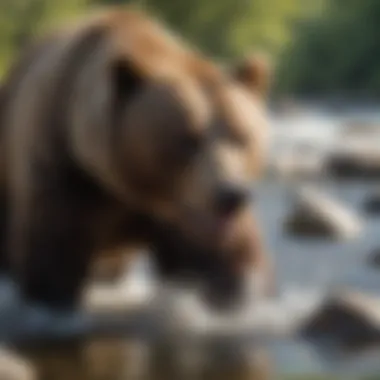Understanding the Brown Bear: Ecology and Conservation


Intro
The brown bear is a species that captivates many. Its massive size, strength, and adaptability allow it to thrive in various ecosystems. Understanding its ecology, behavior, and conservation status is crucial for both scientific inquiry and practical conservation efforts. This article explores different dimensions of the brown bear, aiming to provide a comprehensive guide.
Research Overview
Methodological Approaches
A wide variety of research methods have been employed in the study of brown bears. Field studies are often used to observe their behavior in natural habitats. Researchers use GPS collars to track their movements and monitor their interactions with the environment. These techniques help to gather data on their range, population density, and habitat preferences.
Another approach involves genetic analysis. Researchers examine DNA samples to understand genetic diversity among populations. This data is invaluable in identifying distinct populations and understanding how human activities impact these bears.
Significance and Implications
The significance of studying brown bears extends beyond academic interest. Understanding their ecological role helps in habitat management and conservation practices. Brown bears play a critical part in their ecosystem, influencing plant communities through their feeding habits. The survival of this species holds implications for broader ecological balance.
Moreover, research findings inform policymakers about the necessary interventions to protect brown bear habitats. This knowledge contributes to various conservation strategies, from creating protected areas to implementing community engagement programs aimed at reducing human-bear conflicts.
Current Trends in Science
Innovative Techniques and Tools
Recent advancements in technology have transformed research methodologies. Drones, for instance, allow scientists to survey vast areas without disturbing wildlife. With high-resolution cameras, these devices capture vital information on bear populations and their habitats.
Environmental DNA (eDNA) analysis is gaining traction as well. By collecting soil and water samples, researchers can detect the presence of brown bears without direct observation. This non-invasive technique minimizes stress on the animals and provides accurate population data.
Interdisciplinary Connections
The study of brown bears often intersects with various scientific fields, including ecology, genetics, and anthropology. Biologists and ecologists collaborate to understand the impacts of environmental change on bear populations. Furthermore, social scientists may examine the cultural attitudes towards brown bears, influencing public opinion and policy decisions regarding their conservation.
Understanding the multifaceted nature of brown bears enriches conservation strategies. By combining efforts from multiple disciplines, more effective solutions can be implemented to support these magnificent creatures.
Intro to the Brown Bear
The brown bear holds a critical position in the ecological frameworks of various habitats. Its significance stretches beyond the mere existence of a species. Understanding this animal enriches our comprehension of broader environmental processes and the intricate relationships within ecosystems. The study of the brown bear also serves as a window into habitat health and biodiversity.
By delving into this topic, we gain insight into several essential elements:
- Conservation Needs: With their populations facing significant threats, assessing the brown bear's status helps establish vital conservation strategies.
- Ecological Roles: Brown bears are keystone species, meaning their presence or absence alters the entire ecosystem.
- Biological Insights: Their diverse behaviors and adaptations offer valuable data in biology, ecology, and conservation science.
The following sections will explore taxonomy, morphology, geographical distribution, dietary habits, and human interactions, painting a comprehensive portrait of the brown bear. Understanding these aspects can foster more informed protection efforts.
Taxonomy and Classification
The classification system outlines the brown bear's scientific standing within the animal kingdom. Known scientifically as Ursus arctos, the brown bear is a member of the bear family, Ursidae. This family includes other bear species, each with distinct traits and adaptations. Brown bears are further divided into various subspecies based on geographical distribution and physical characteristics, such as the Kodiak bear and the grizzly bear. Understanding their taxonomy is fundamental for conservation purposes, as it highlights the diversity within the species and specific needs of different populations.
Historical Significance
The historical significance of brown bears cannot be overstated. These animals have inhabited our planet for over two million years, adapting to a variety of environments. Throughout history, they have influenced cultural narratives and ecosystems. In many indigenous cultures, brown bears are symbols of strength and survival, representing a deep connection to the land. This relationship has shaped human perceptions and interactions with these formidable creatures.
Understanding the history of the brown bear aids in recognizing how human activities, such as hunting and habitat destruction, have altered their populations over time. Acknowledging this past can guide contemporary conservation strategies, ensuring a more sustainable coexistence between humans and wildlife.
Morphology of Brown Bears
The study of brown bear morphology details the physical characteristics that define this species. Understanding morphology is crucial for multiple reasons, including identifying adaptations that facilitate survival, communicating behaviors, and aiding in conservation efforts. The physical traits, like size and sensory systems, play significant roles in the ecological niche occupied by brown bears. These aspects help clarify how they interact with their environment and the importance of their presence within ecosystems.
Physical Characteristics
Size and Weight
Brown bears exhibit considerable variation in size, depending on their subspecies and habitat. Adult males can weigh between 300 to 1,500 pounds, while females generally weigh 10-30% less. This substantial size contributes to their role as apex predators in their ecosystems. The larger mass enables them to compete effectively for food resources and defend against other predators.
A unique feature regarding the size of brown bears is the remarkable difference between various populations. For example, the Kodiak bear stands as one of the largest, rivaling polar bears in mass. This variation illustrates adaptive traits, with larger bears often found in nutrient-rich locales.
Fur and Color Variations
Fur is another significant characteristic in brown bears, ranging from light blonde to almost black, often with a distinctive reddish hue. This variation aids in camouflage, allowing them to blend effectively into their habitats, whether they inhabit forests or tundra.
The different fur colors can impact thermoregulation. Darker fur absorbs sunlight, which can be advantageous in colder climates yet might increase heat stress in warmer areas. Thus, color variation is essential not only for survival but also for reproductive success within different environments.
Sensory Adaptations
Vision
Brown bears possess adequate vision, which supports their ability to navigate and locate food. While they do not see as clearly as humans, their vision works better in low light conditions. This characteristic ensures they can hunt during dawn and dusk, optimizing their foraging behavior. They can detect movement even in dense vegetation, crucial for spotting potential prey or rivals.
A notable aspect of their vision is the reliance on motion detection rather than clarity. This adaptation supports their predatory lifestyle, allowing them to capitalize on movement, which is often a sign of potential food.
Hearing
Hearing is highly developed in brown bears. They can detect sounds at lower frequencies than humans, allowing them to hear prey or threats from considerable distances. This heightened sense lets them locate mates during the mating season or find food sources like salmon in rivers.
The sensitivity of their hearing also plays a role in social communication. Bears communicate through various sounds, and acute hearing helps them assess social situations in their vicinity.


Smell
Brown bears have one of the most powerful senses of smell among terrestrial mammals, with olfactory receptors estimated to be several times more effective than those of dogs. This exceptional sense allows them to detect food from miles away, identify mates, and assess the presence of danger or competitors.
The significance of their sense of smell is profound in foraging behavior. They can find carrion and locate berries or nuts hidden under layers of foliage. This ability directly impacts their survival and, ultimately, population dynamics.
The morphological and sensory adaptations of brown bears play critical roles in their survival, influencing foraging success, mating, and interactions within their ecosystems.
Understanding these characteristics provides insight into the ecological role of brown bears, highlighting the necessity for informed conservation practices as they face various threats.
Geographical Distribution
Geographical distribution is a crucial aspect of understanding brown bears. It provides insights into their habitat preferences and population dynamics. By mapping their habitats and ranges, researchers can identify the health of ecosystems that support these bears. This section will explore various habitats that brown bears occupy across the globe.
Habitat Preferences
Forest Ecosystems
Forest ecosystems are vital for brown bears. They provide ample food sources, cover, and breeding grounds. The dense vegetation supports a variety of plant species which are essential in the bears’ omnivorous diet. One key characteristic of forest ecosystems is their biodiversity, which often includes other prey animals alongside plants. The multifaceted interactions within forest habitats contribute to the overall health of bear populations, making these ecosystems a beneficial choice for our study.
A unique feature of forest ecosystems is the seasonal availability of fruits and nuts. These food sources not only attract bears but also sustain them during hibernation. However, forest habitats can be fragmented due to human activities, posing challenges to bear populations.
Tundra Environments
Tundra environments offer an insulated ecosystem that supports the brown bear's life cycle. This harsh environment influences their foraging behavior and seasonal migrations. One key characteristic of tundra ecosystems is the limited vegetation, which makes food resources sparse. Nevertheless, during the berry season, brown bears often migrate to tundra areas that become rich in such resources. This seasonal variation makes tundra an important focus in our exploration of habitat preferences.
What sets tundra environments apart is its extreme seasonality. The availability of food changes drastically, which influences bear behavior. This unpredictability can make survival challenging for bears, underscoring the importance of habitat preservation in these areas.
Mountain Regions
Mountain regions represent another significant habitat for brown bears. The elevation and terrain provide unique opportunities for foraging and shelter. A key characteristic of mountain environments is their ruggedness, which often keeps human interference at bay. This makes such regions a beneficial choice for brown bears seeking solitude.
A distinct feature of mountain regions is their climate variability, which impacts the bear's adaptation strategies. Altitudinal migration allows bears to exploit different ecological niches. However, mountain habitats may also be less productive than lowland ecosystems, especially if food sources are limited.
Population Distribution
North America
North America is home to a diverse array of brown bear populations. The continent's vast landscapes provide varied habitats, from coastal forests to mountainous terrains. One key characteristic of North America is its relatively stable bear populations, especially in regions with strong conservation efforts. This aspect makes it a vital focus point when examining the brown bear's future.
A unique feature of North America's population distribution is the presence of significant protected areas. These reserves not only support healthy bear populations but also encourage biodiversity conservation. The advantages of this setup include reduced human-wildlife conflict, allowing bears to thrive in their natural habitats.
Eurasia
In Eurasia, brown bear populations extend through a broad range of climates and terrains. The diversity of habitats, from dense forests to tundra, contributes to the adaptability of the species. A key characteristic of Eurasia is the variability in population density. This is particularly influenced by human encroachment and habitat fragmentation. The differences in conservation status across various countries also make this region noteworthy in our overall study.
A notable feature of Eurasia is the cultural significance attributed to brown bears, with some regions developing robust conservation policies in response to local traditions. The advantages of studying this area include understanding the intersection of culture and wildlife conservation, highlighting the importance of human perception in preserving bear populations.
"Conservation efforts in both regions are essential to ensure the survival of brown bears in the wild. Their distribution patterns are influenced by ecological factors as much as by human activities."
This section clarifies the geographical distribution of brown bears, providing a foundation for understanding their ecology, behavior, and conservation needs.
Diet and Foraging Behavior
Understanding the diet and foraging behavior of brown bears is paramount for grasping their ecological role and the factors influencing their populations. As omnivores, brown bears consume a varied diet, consisting of both plant matter and animal protein. This diverse eating habit allows them to adapt to different environments and seasonal changes, making them versatile foragers. The way they forage also affects their conservation status and the ecosystems where they reside. Thus, studying their dietary choices provides crucial insights into their health, population dynamics, and ecological importance.
Omnivorous Diet
Brown bears have an omnivorous diet, which is key to their survival and adaptability. This diet encompasses a wide range of food sources, including fruits, nuts, insects, fish, and small mammals. Each component plays a vital role in their nutrition and foraging strategies.
Plant Matter
Plant matter such as berries, roots, and nuts forms a significant portion of a brown bear's diet. This component is particularly rich in carbohydrates and provides the necessary energy for their rigorous lifestyle. Berries, like blueberries and raspberries, are often sought after because they are abundant in summer months and easily accessible.
The unique feature of plant matter is that it varies in availability throughout the year. In spring, bears often seek young green shoots, while autumn sees them foraging for nuts before hibernation. One advantage of consuming plant matter is its high availability, especially in forest ecosystems. However, during lean seasons, bears may struggle to find sufficient plant-based food, which makes understanding these variations critical in assessing their diet.
Animal Protein
Animal protein is another integral part of the brown bear's diet. They predominantly target fish, particularly salmon, during spawning seasons. The high-fat content in fish is especially beneficial, providing essential nutrients required for weight gain before hibernation. In addition to fish, brown bears might scavenge on carrion or hunt small mammals, which contributes to their protein intake.
The distinctive aspect of animal protein is its nutrient density, which is often higher than that of most plant matter. One significant advantage of this protein source is its contribution to muscle development and overall health, crucial for their active lifestyle. However, hunting or scavenging carries risks and may not always yield consistent food results. This reliance on both plant matter and animal protein demonstrates the adaptability of brown bears in various habitats, ensuring they optimize their foraging strategies depending on seasonal availability.
Foraging Strategies
The foraging strategies of brown bears are influenced by seasonal availability, which plays a crucial role in how they optimize their diets. Seasonal variations dictate the types of food accessible at different times of the year, compelling brown bears to adapt their eating activities to maximize nutrient intake.
Seasonal Variations
Seasonal variations significantly impact the brown bear's foraging behavior and dietary choices. During spring, bears emerge from hibernation, seeking high-calorie foods to replenish their energy reserves. In summer, the availability of fruits, nuts, and insects peaks, allowing for a varied diet. Autumn is particularly critical, as bears prepare for the harsh winter ahead by consuming large quantities of food to accumulate fat.
This adaptability allows brown bears to thrive in diverse environments, as they adjust their diets according to seasonal fluctuations. The benefit of recognizing these seasonal variations lies in their capacity for survival, as a well-planned foraging strategy ensures they meet their nutritional needs throughout the year.
Tool Use in Foraging
Interestingly, brown bears exhibit tool use in their foraging behavior, a unique trait among many wildlife species. They may use their paws and even rocks to help access food sources. For example, they might use rocks to crack open shellfish or dig at specific locations to uncover roots or insect dens.


This characteristic showcases their intelligence and ability to innovate in their search for food. Utilizing tools not only enhances their foraging efficiency but also aids in accessing harder-to-find food during periods of scarcity. Understanding this behavior emphasizes the complexity of their foraging strategies and highlights the need for more detailed ecological studies to assess how they employ these skills to secure food.
Behavioral Ecology
The behavioral ecology of brown bears serves as a critical framework for understanding their adaptations to the environment that they inhabit. This aspect encompasses a wide array of behaviors that promote survival and reproduction. These behaviors are influenced by ecological factors such as food availability, habitat conditions, and interspecies relationships. The adaptive strategies of brown bears, from foraging to mating, reflect environmental pressures. In this article, behavioral ecology aids in delineating how brown bears function within their ecosystems, revealing their roles and intrinsic value within these systems.
Social Structure
Solitary vs. Social Behavior
Brown bears are primarily known for their solitary nature. This characteristic is a fundamental aspect of their social structure. Solitary behavior often emerges as a beneficial strategy, particularly for foraging efficiency. When bears are alone, they can exploit resources without competition. However, in certain circumstances, such as during mating season or when food is abundant, they may exhibit social behavior. This flexibility allows them to adapt to environmental conditions effectively.
A unique aspect of their social behavior is that it can vary by region and availability of resources. In areas where food is plentiful, bears may tolerate one another's presence, which enhances social learning and reduces isolation, but this can also lead to increased competition.
Mother-Offspring Interactions
The bond between a mother bear and her cubs is one of the most crucial aspects of their social structure. This interaction is particularly significant for the survival of the young. Mothers typically invest a lot of time and energy into raising their cubs, teaching them essential skills for survival. It highlights nurturing traits, which are rare in many apex predators. The key characteristic of this behavior is the protective nature of the mother during the tender stages of the cub's life. It provides safety and guidance until they are mature enough to fend for themselves.
The unique feature of mother-offspring dynamics is that it fosters a strong learning environment. Cubs gain knowledge about habitat navigation, foraging techniques, and recognizing threats. However, this close-knit bond can be disadvantageous in changing environments; if a mother faces a decrease in food availability, it may struggle to support all offspring, which can lead to tough decisions about survival.
Reproductive Behavior
Mating Rituals
Mating rituals in brown bears are intricate and vary by local population. The rituals mostly occur in late spring or early summer, timed to ensure optimal conditions for cub rearing. One notable aspect is the unique vocalizations and body language bears use to communicate readiness to mate.
This specific behavior plays an essential role in ensuring that mating pairs find each other in vast habitats. While this could seem trivial, it is a significant choice in ensuring genetic diversity. However, the limitations of these signals can also lead to missed opportunities during mating season.
Cub Rearing
Cub rearing behavior highlights the care and nurturing that brown bears provide. A female bear usually gives birth to one to four cubs, which are dependent on her for survival in their early years. This dependence shapes their development and socialization. The mother’s role during this phase extends beyond provisioning; she also teaches them social skills and survival tactics. This not only influences the cubs’ chances of survival but also contributes to the stability of the overall bear population.
A unique benefit of this detailed nurturing process is that it strengthens the mother-cub bond, ensuring better guidance. However, this devoted nurturing also poses risks; a mother with cubs becomes vulnerable to threats, and any loss during rearing can significantly affect her future reproductive success.
Hibernation Patterns
Hibernation in brown bears is a remarkable adaptation to seasonal changes. It allows them to survive during the harsh winter months when food is scarce. During this period, their metabolic rate decreases significantly, allowing them to conserve energy. This adaptation is vital for survival and reflects their ability to cope with environmental challenges. The hibernation pattern is not uniform and varies with geographic and environmental factors. It influences feeding behaviors leading up to hibernation, as bears consume large amounts of food to accumulate fat reserves.
Understanding these patterns is crucial not only for the conservation efforts surrounding brown bears but also for comprehending their ecological roles.
In summary, the behavioral ecology of brown bears encapsulates their adaptations, interactions, and survival strategies. Through the examination of social structures, reproductive behaviors, and hibernation patterns, one gains an expansive view of their life cycle and the ecological significance they hold.
Ecological Role of Brown Bears
The ecological role of brown bears is profound and multifaceted. They are often considered a keystone species within their habitat. This means that their presence and behaviors significantly affect the structure of the ecosystem and the species that inhabit it. Understanding the specific contributions of brown bears helps us appreciate the balance of their environments and highlights the importance of their conservation.
Keystone Species
Brown bears play an essential role as a keystone species in their ecosystems. They help maintain the health of various habitats in several ways:
- Nutrient Distribution: Brown bears have a varied diet and their foraging activities spread nutrients across vast landscapes. When they consume salmon in river streams and subsequently defecate in the surrounding forests, they distribute vital nitrogen and other nutrients into the soil.
- Prey Control: Through their predation habits, they help regulate populations of other species, ensuring that no single species dominates the ecosystem. This balance prevents overgrazing and allows plant communities to thrive.
- Habitat Modification: Their physical activities, like digging and tree-stumping, alter habitats in ways that create niches for other species. This creates opportunities for different plants and animals to flourish, promoting biodiversity.
In a broader sense, the health of brown bear populations is an indicator of ecosystem health. Tracking their numbers can provide critical insights into the state of their environment.
Impact on Ecosystem Health
The impact of brown bears on ecosystem health can be observed through various mechanisms:
- Biodiversity Enhancement: As brown bears forage, their activities inadvertently create habitats for various other species. This interdependence fosters rich biodiversity, which is crucial for resilient ecosystems.
- Seed Dispersal: By consuming fruits and then excreting the seeds elsewhere, bears assist in plant reproduction. This natural process supports forest regeneration and increases plant species diversity.
- Scavenging Opportunities: After hunting or consuming significant amounts of food, brown bears leave behind carcasses. These remains benefit numerous scavengers, including birds and smaller mammals, contributing to a cycle of life and decay that enriches the ecosystem.
The role of brown bears in an ecosystem cannot be understated. Their behaviors and interactions contribute significantly to the survival of other species and the overall health of the environment.
In summary, the ecological role of brown bears extends beyond their immediate needs and actions. They sustain and enhance the environments in which they live, affecting multiple levels of biodiversity and ecosystem functionality. Recognizing this is essential in advocating for their conservation.
Conservation Status
The conservation status of the brown bear is a crucial aspect of understanding its survival and ecological role. This section addresses the various threats the species faces and the efforts to mitigate these challenges, providing a comprehensive overview essential for both conservationists and the interested public. The urgency of preserving brown bears highlights the interdependence between wildlife health and ecosystem stability. As apex predators, their presence affects many other species and the environment they inhabit.
Threats to Survival
Habitat Loss
Habitat loss is one of the most pressing issues for brown bears. This occurs due to urban development, logging, and agricultural expansion. When their habitats are destroyed, brown bears face the challenge of finding food, shelter, and mating opportunities. This factor not only reduces their population but also compromises genetic diversity. It is a central concern in this article because habitat loss directly impacts the bears' ability to thrive in the wild. Brown bears are known to travel long distances in search of habitats suitable for feeding and breeding; however, fragmented environments make such movements increasingly difficult.
Climate Change
Climate change significantly affects brown bear habitats. As temperatures rise, the distribution of their food sources changes. Plant and animal life cycles are altered, leading to mismatches in availability. Brown bears rely on seasonal food sources, especially when preparing for hibernation. The unpredictability in climate patterns poses a threat not just to their nutrition but also to their reproductive cycles. In this article, climate change is an important element because it encompasses a broader context of environmental challenges faced by numerous species. The unique feature of climate change is its cumulative effects. It can exacerbate habitat loss and increase human-bear interactions, creating a multifaceted problem.
Human-Wildlife Conflict
Human-wildlife conflict arises when brown bears invade human-dominated areas, often driven by a lack of available natural food. This can lead to negative encounters, resulting in bears being killed or relocated. This area of discussion is vital as it highlights the struggle of coexistence between humans and bears. The unique feature of human-wildlife conflict is its psychological aspect; fear often drives communities to take drastic measures against wildlife. The consequences can be detrimental, not just for brown bears but also for local ecosystems, as their removal can have cascading effects on other wildlife species.
Current Conservation Efforts


Protected Areas
Protected areas play a vital role in the conservation of brown bears. These designated regions, which include national parks and wildlife reserves, provide safe habitats free from human encroachment. Such areas facilitate natural behavior and allow populations to flourish. The significance of protected areas lies in their ability to maintain ecosystem balance. In this article, they emphasize the need for thoughtful land management practices. One unique feature of protected areas is their potential as educational tools for raising awareness about conservation.
Legislative Measures
Legislative measures, including local and international laws protecting brown bears, are crucial for their survival. Such regulations often involve restrictions on hunting and habitat destruction. Strong laws are beneficial as they provide a legal framework for conservation efforts. The distinctive characteristic of these measures is their emphasis on compliance and enforcement. Effective legislation can result in improved population numbers over time. In this article, the discussion around legislative efforts is pivotal, as it links human action to the welfare of wildlife.
Human Interactions
Understanding human interactions with brown bears is vital to grasp the complexities surrounding their conservation and ecological significance. This topic encompasses various elements such as cultural significance and coexistence strategies, which directly affect the relationship between humans and these formidable animals. By examining these interactions, we can identify beneficial actions and address potential conflicts, ultimately promoting a sustainable future for both brown bears and humans.
Cultural Significance
Mythology and Folklore
The mythology and folklore related to brown bears reveal a deep-seated respect and connection people have had with these animals throughout history. Different cultures view brown bears as symbols of strength, courage, and wisdom. For instance, many Native American tribes respect the bear as a totem animal, representing powerful spiritual forces. This cultural significance enriches the overall understanding of brown bears, serving as a bridge between nature and humanity.
Moreover, these narratives highlight the need to preserve the bear's habitat. As humans engage with these stories, it can foster a sense of responsibility. By promoting the cultural importance of bears, we reinforce their protection in the face of habitat destruction.
However, reliance on folklore can have disadvantages. It may lead to romanticized views, causing individuals to underestimate the dangers associated with wild bears or overlook important conservation challenges.
Wildlife Tourism
Wildlife tourism revolves around the observation and interaction with natural environments and their inhabitants, including brown bears. This aspect generates significant revenue and increases awareness of conservation issues. Tourists often travel to bear habitats to witness their behavior in natural settings, contributing to local economies. This economic benefit is a key characteristic, making wildlife tourism a popular choice for this article.
It has unique features that enhance its effectiveness in conservation. For instance, profits from tourism often fund conservation projects, directly supporting efforts to protect bear populations. However, there are concerns regarding the negative impact tourism can have on their natural behavior. Too much human presence may stress the bears, disrupt their habitats, or even lead to dangerous encounters. Thus, responsible tourism practices are critical to balancing benefits and drawbacks.
Coexistence Strategies
Coexistence strategies play a crucial role in the efforts to live harmoniously with brown bears. As human activities continue to encroach upon their habitats, finding effective methods for coexistence becomes increasingly important.
Community Education
Community education focuses on raising awareness about brown bears and their habits. This initiative encourages safe coexistence by informing people about how to avoid bear encounters and the role bears play in the ecosystem. By informing communities, we empower them to participate in conservation efforts actively. This focal point enhances the overall goal of ensuring the survival of brown bears.
Unique aspects include tailored programs that address specific local circumstances. Such initiatives have advantages, such as fostering positive attitudes and reducing fear or misconceptions about brown bears. However, it can have limitations in areas where resistance to change is strong.
Mitigation Practices
Mitigation practices involve proactive measures to minimize conflicts between humans and brown bears. These strategies encompass a range of actions, from securing trash and food sources to installing bear-proof fencing. By implementing these practices, it becomes easier to reduce negative encounters, which is essential for both species' well-being.
The key characteristic of mitigation practices lies in their practical applications. They serve as a foundation for minimizing human-bear conflicts, which strengthens community ties and enhances safety. However, these practices need continuous evaluation and adaptability to changing conditions in bear populations and human behaviors.
Future Directions for Research
Exploring the future directions of research on brown bears is crucial for understanding their ecology and enhancing conservation strategies. As global environmental conditions evolve, research must adapt to address emerging challenges facing these species. Investigating genetic diversity and climate response can provide insights into how brown bears might cope with increasing threats and changes in habitat. This focus on scientific inquiry is essential not only for developing effective conservation methods but also for fostering a more profound appreciation of the brown bear's role in the ecosystem.
Genetic Studies
Genetic studies play a pivotal role in understanding the brown bear’s resilience. These studies can reveal patterns of gene flow, population structure, and genetic diversity among different brown bear populations. Such information is vital for making informed decisions about conservation strategies. For instance, understanding how genetic variation affects adaptability is key for managing isolated populations.
In recent years, technology has improved the ability to analyze genetic material from sizable populations of brown bears. Techniques like genome sequencing can pinpoint specific adaptations to climates or diseases. This knowledge not only aids in identifying which populations may be more vulnerable to extinction but also helps in crafting effective breeding programs and wildlife corridors.
- It is well documented that higher genetic diversity within a population often leads to greater resilience to environmental stressors.
Climate Response Research
Climate response research investigates how brown bears adapt to changing environmental conditions. As climate change progresses, it's vital to understand how these animals will respond. Such studies focus on several factors, including changes in food availability and habitat disruption.
Research has shown that brown bears depend heavily on seasonal food cycles, which are being affected by climate shifts. An exploration into how these factors influence bear behavior and population dynamics is critical. Researchers must assess how rising temperatures, altered precipitation patterns, and changing ecosystems impact bear migration, breeding, and foraging habits.
By employing long-term ecological studies, scientists can gather data on these species' responses to climate fluctuations over time. This information will be valuable for conservationists aiming to implement proactive strategies.
In summary, focusing on genetic studies and climate response is crucial for understanding the future of brown bears. As these studies advance, they will inform better management and conservation decisions, ultimately aiding in the survival of this iconic species.
End
The conclusion of this article holds significant importance as it encapsulates the extensive examination of the brown bear's ecology, behavior, and conservation needs. It serves as a final reminder of the intricate connections between this majestic species and its environment. Understanding these connections is critical, not only for conservationists but also for the general public who may influence policies and attitudes towards wildlife.
By revisiting key points about the brown bear's role as a keystone species, the challenges it faces today, and the ongoing efforts to conserve its habitat, readers can better appreciate the complexity of the issues at hand. This section synthesizes various elements that have been discussed throughout the article, ensuring that the importance of informed action is adequately conveyed.
Furthermore, it emphasizes the need for continuous research and education to inform conservation strategies. The survival of brown bears is closely linked to the health of the ecosystems they inhabit; therefore, understanding their role helps to ensure those ecosystems are prioritized in conservation efforts.
"A comprehensive understanding of brown bears informs not just conservation efforts but highlights the intricate balance of nature that sustains all species, including humanity."
Ultimately, this conclusion guides readers to think critically about the consequences of human actions on wildlife. It frames the necessity for a concerted effort in conservation, ensuring that brown bears continue to thrive in their natural habitats for generations to come.
Summary of Key Points
- Brown bears are a keystone species, playing a crucial role in maintaining ecological balance.
- They face numerous threats such as habitat destruction, climate change, and conflicts with humans.
- Conservation measures include establishing protected areas and implementing legislative actions to safeguard their populations.
- Understanding brown bears enhances public awareness, fostering a sense of responsibility toward wildlife conservation.
Call to Action for Conservation
To effectively ensure the preservation of brown bears and their habitats, individual and collective actions are essential. Here are some steps that can be taken:
- Support Conservation Organizations: Engage with or donate to organizations focused on wildlife conservation, such as the World Wildlife Fund or the Bear Trust.
- Advocate for Sustainable Practices: Encourage local and global policies that prioritize sustainable development and habitat preservation.
- Participate in Educational Programs: Join workshops or community programs that educate others about the importance of brown bears and their role in the ecosystem.
- Report Human-Wildlife Conflicts: If you live in areas where brown bears are present, learn how to minimize conflicts and report any encounters to wildlife authorities.
- Get Informed: Read articles, follow research, and stay updated on the latest findings related to brown bear conservation and ecology. Knowledge is a powerful tool in conservation efforts.
In summary, every action contributes to a larger movement toward a future where brown bears and their habitats are protected. Together, we can work towards a balance that benefits wildlife and humans alike.



